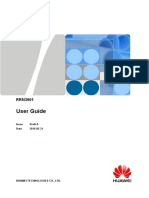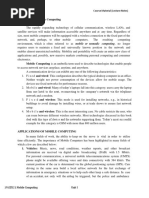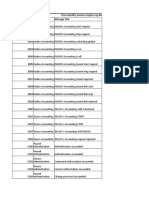Definitions: Mobile Computing
Definitions: Mobile Computing
Uploaded by
Vanitha MaryCopyright:
Available Formats
Definitions: Mobile Computing
Definitions: Mobile Computing
Uploaded by
Vanitha MaryOriginal Description:
Original Title
Copyright
Available Formats
Share this document
Did you find this document useful?
Is this content inappropriate?
Copyright:
Available Formats
Definitions: Mobile Computing
Definitions: Mobile Computing
Uploaded by
Vanitha MaryCopyright:
Available Formats
MOBILE COMPUTING
Mobile computing is humancomputer interaction by which a computer is expected to be transported during normal usage. Mobile computing involves mobile communication, mobile hardware, and mobile software. Communication issues include ad hoc and infrastructure networks as well as communication properties, protocols, data formats and concrete technologies. Hardware includes mobile devices or device components. Mobile software deals with the characteristics and requirements of mobile applications.
Definitions
Mobile Computing is "taking a computer and all necessary files and software out into the field".[1] Mobile computing is any type of computing which use Internet or intranet and respective communications links, as WAN, LAN, WLAN etc. Mobile computers may form a wireless personal network or a piconet. There are at least three different classes of mobile computing items:
portable computers, compacted lightweight units including a full character set keyboard and primarily intended as hosts for software that may be parametrized, as laptops, notebooks, notepads, etc. mobile phones including a restricted key set primarily intended but not restricted to for vocal communications, as cell phones, smart phones, phonepads, etc. wearable computers, mostly limited to functional keys and primarily intended as incorporation of software agents, as watches, wristbands, necklaces, keyless implants, etc.
The existence of these classes is expected to be long lasting, and complementary in personal usage, none replacing one the other in all features of convenience..
Devices
Many types of mobile computers have been introduced since the 1990s including the:
Personal digital assistant/enterprise digital assistant Smartphone Tablet computer Ultra-Mobile PC Wearable computer
Limitations
Range & Bandwidth: Mobile Internet access is generally slower than direct cable connections, using technologies such as GPRS and EDGE, and more recently HSDPA and HSUPA 3G and 4G networks. These networks are usually available within range of
commercial cell phone towers. Higher speed wireless LANs are inexpensive but have very limited range. Security standards: When working mobile, one is dependent on public networks, requiring careful use of VPN. Security is a major concern while concerning the mobile computing standards on the fleet. One can easily attack the VPN through a huge number of networks interconnected through the line. Power consumption: When a power outlet or portable generator is not available, mobile computers must rely entirely on battery power. Combined with the compact size of many mobile devices, this often means unusually expensive batteries must be used to obtain the necessary battery life. Transmission interferences: Weather, terrain, and the range from the nearest signal point can all interfere with signal reception. Reception in tunnels, some buildings, and rural areas is often poor. Potential health hazards: People who use mobile devices while driving are often distracted from driving and are thus assumed more likely to be involved in traffic accidents.[2] (While this may seem obvious, there is considerable discussion about whether banning mobile device use while driving reduces accidents or not.[3][4]) Cell phones may interfere with sensitive medical devices. Questions concerning mobile phone radiation and health have been raised. Human interface with device: Screens and keyboards tend to be small, which may make them hard to use. Alternate input methods such as speech or handwriting recognition require training.
You might also like
- Seminar On Mobile ComputingDocument19 pagesSeminar On Mobile Computingsubhro6667% (3)
- Traffic Analysis Exercise AnswersDocument12 pagesTraffic Analysis Exercise AnswersTayyabNo ratings yet
- Mcafee Network Security Platform 10.1.x Manager API Reference Guide 5-6-2022Document1,399 pagesMcafee Network Security Platform 10.1.x Manager API Reference Guide 5-6-2022Duy VuNo ratings yet
- RRN3901 User Guide (v100r011c10)Document96 pagesRRN3901 User Guide (v100r011c10)leonardomarinNo ratings yet
- ipLDK 20 Programming Manual Manual PDFDocument511 pagesipLDK 20 Programming Manual Manual PDFMauro PaloschiNo ratings yet
- Mobile ComputingDocument2 pagesMobile ComputingVaishnavi RamadassNo ratings yet
- Wireless Application ProtocolDocument3 pagesWireless Application ProtocolSulagna DharNo ratings yet
- Mobile Computing CHKDocument7 pagesMobile Computing CHKSushil SinghNo ratings yet
- Mobile ComputingDocument21 pagesMobile Computingsadhanamca1No ratings yet
- All About Mobile ComputingDocument4 pagesAll About Mobile ComputingAnand AhirwarNo ratings yet
- Sekolah Menengah Kebangsaan Jasin 77000 Jasin Melaka: The Latest Development in Networks and CommunicationDocument14 pagesSekolah Menengah Kebangsaan Jasin 77000 Jasin Melaka: The Latest Development in Networks and CommunicationZarina MohammedNo ratings yet
- Fourth Form - Computer Network and Web Technologies HandoutDocument11 pagesFourth Form - Computer Network and Web Technologies HandoutNahuuma SmithNo ratings yet
- 1.1 IntroductionDocument4 pages1.1 Introductionyabocew846No ratings yet
- 4.mobile ComputingDocument9 pages4.mobile Computingsuri0422No ratings yet
- CDIT 404 - Introduction To Wireless and Mobile ComputingDocument5 pagesCDIT 404 - Introduction To Wireless and Mobile ComputingMayur Hitesh RabadiaNo ratings yet
- Reported By:: Dandel Anne Calimlim Edlyn ElaneDocument38 pagesReported By:: Dandel Anne Calimlim Edlyn ElanerinlacerNo ratings yet
- 1.introductionc Mobile Computingc CC C CC C C C C C C CDocument4 pages1.introductionc Mobile Computingc CC C CC C C C C C C CFiqri MohidinNo ratings yet
- Mobile ComputingDocument35 pagesMobile ComputingBridget Smith100% (3)
- Mobile Computing - Wikipedia, The Free EncyclopediaDocument7 pagesMobile Computing - Wikipedia, The Free EncyclopediaShweta KhandelwalNo ratings yet
- The Latest Development in Networks and CommunicationDocument7 pagesThe Latest Development in Networks and CommunicationYang Nabil Yang SharkawiNo ratings yet
- Mobile Computing: UNIT-I NotesDocument29 pagesMobile Computing: UNIT-I NotesDhruv BhandariNo ratings yet
- Activity 1 1. What Is Computer Networks?Document9 pagesActivity 1 1. What Is Computer Networks?Katrina Mae VillalunaNo ratings yet
- Types of NetworksDocument20 pagesTypes of NetworksReks DiscreetNo ratings yet
- MC - unit 1 to 5Document102 pagesMC - unit 1 to 5ajayajay53688No ratings yet
- Seminar By:-Sujata Malik Mca 5 SEM Roll No: - 57Document15 pagesSeminar By:-Sujata Malik Mca 5 SEM Roll No: - 57Rohin RangnekarNo ratings yet
- Mobile ComputingDocument62 pagesMobile Computingdbox026No ratings yet
- Mobile ComputingDocument5 pagesMobile ComputingaditronNo ratings yet
- Wireless Communication1234Document13 pagesWireless Communication1234AbhijitNo ratings yet
- Section 1 - Distinguish Among Ttypes of NetworksDocument7 pagesSection 1 - Distinguish Among Ttypes of NetworksJade SpencerNo ratings yet
- Mobile Computing: A Technology That Allows Transmission of Data, Via A ComputerDocument9 pagesMobile Computing: A Technology That Allows Transmission of Data, Via A ComputerAshok KumarNo ratings yet
- Mobile Computing-Book - 16-3-2026-Pages-1Document13 pagesMobile Computing-Book - 16-3-2026-Pages-1Ahmed JubranNo ratings yet
- Security Considerations in Mobile ComputingDocument20 pagesSecurity Considerations in Mobile ComputingMani RAiNo ratings yet
- 802.11 Standard: of 1.4 YearsDocument10 pages802.11 Standard: of 1.4 YearsARVIND100% (1)
- MobileDocument18 pagesMobileaastha maheshwariNo ratings yet
- Mobile ComputingDocument95 pagesMobile ComputingJohnpaulNo ratings yet
- Unit-1 MCDocument21 pagesUnit-1 MCJohnpaulNo ratings yet
- Benefits of Wireless TechnologyDocument11 pagesBenefits of Wireless TechnologyAdemola AdesiyiNo ratings yet
- Unit-1 Mobile CommunicationsDocument31 pagesUnit-1 Mobile CommunicationsKanteti Sai KrishnaNo ratings yet
- MC Unit 1Document34 pagesMC Unit 1Akshat AjayNo ratings yet
- Practical - 06: Wired and Wireless Communication With Different ApplicationDocument8 pagesPractical - 06: Wired and Wireless Communication With Different ApplicationSohan ChavhanNo ratings yet
- Networks and Web TechDocument18 pagesNetworks and Web TechwilliamsonmelaniaNo ratings yet
- Wireless Chapter 1Document10 pagesWireless Chapter 1kibertemesgen78No ratings yet
- Mobile Application Development: Chapter-1 1.evolution of Mobile ComputingDocument22 pagesMobile Application Development: Chapter-1 1.evolution of Mobile ComputingBharath CrNo ratings yet
- Mobile ComputingDocument82 pagesMobile Computingt.ambika1991No ratings yet
- Comuter Networks & Web Technology - Revision Notes 12aDocument20 pagesComuter Networks & Web Technology - Revision Notes 12aLiaNo ratings yet
- Wireless20102011 2Document37 pagesWireless20102011 2Ana MuslimahNo ratings yet
- Computer Networks and Communications: Specification of Mobile ComputingDocument5 pagesComputer Networks and Communications: Specification of Mobile ComputingSuEz AzIzNo ratings yet
- M2mobile Computing1Document25 pagesM2mobile Computing1ansariazad7864No ratings yet
- Computing and IT in The WorkplaceDocument40 pagesComputing and IT in The WorkplaceSreePrakash100% (1)
- Unit 3Document65 pagesUnit 3Prabin ChaudharyNo ratings yet
- UNIT-1 Mobile ComputingDocument23 pagesUNIT-1 Mobile ComputingShobhit TiwariNo ratings yet
- Mobile Computing NotesDocument10 pagesMobile Computing NotesMehul AroraNo ratings yet
- Chapter 7 Wireless, Mobile Computing, and Mobile Commerce (Student Slide) - 0 - 0Document56 pagesChapter 7 Wireless, Mobile Computing, and Mobile Commerce (Student Slide) - 0 - 0nona100% (1)
- Mobile Computing FundamentalsDocument9 pagesMobile Computing FundamentalsMatiko DesalegnNo ratings yet
- Mc Qb AnswersDocument71 pagesMc Qb Answers2021cs0629No ratings yet
- Communication Networks: 2.2. Second-Generation Wireless CommunicationDocument6 pagesCommunication Networks: 2.2. Second-Generation Wireless CommunicationcvsueeeNo ratings yet
- Introduction To Computer Networks PDFDocument10 pagesIntroduction To Computer Networks PDFWanessa RodriguesNo ratings yet
- Mc-Unit IDocument16 pagesMc-Unit IShankara NarayananNo ratings yet
- Mobile Communiction Notes - Unit IDocument24 pagesMobile Communiction Notes - Unit ICSE 25 Bhaarat KrishnanNo ratings yet
- Chapter #1Document24 pagesChapter #1Akshay RathodNo ratings yet
- The Impact of 5G on Society: 5G technology can connect people, devices, infrastructures, and objects.From EverandThe Impact of 5G on Society: 5G technology can connect people, devices, infrastructures, and objects.No ratings yet
- PCM EngineeringDocument81 pagesPCM EngineeringRK KNo ratings yet
- RRQ King of PUBG Mobile Tournament (Respons)Document8 pagesRRQ King of PUBG Mobile Tournament (Respons)AnggaAndaramaNo ratings yet
- MSFT Cloud Architecture Identity PDFDocument6 pagesMSFT Cloud Architecture Identity PDFSan FerozNo ratings yet
- Hours Spent On Social Media: 1. How Many Hours Do You Spend On Social Networking Sites Per Day?Document15 pagesHours Spent On Social Media: 1. How Many Hours Do You Spend On Social Networking Sites Per Day?Ocean Media GirlsNo ratings yet
- FCCID - Io Users Manual Users Manual 3088164Document25 pagesFCCID - Io Users Manual Users Manual 3088164ellonndlovuNo ratings yet
- Ise LogsDocument168 pagesIse LogsDenis EgusquizaNo ratings yet
- Label Indoor 2300Document1 pageLabel Indoor 2300Citra LahengkeNo ratings yet
- 5.2.1.7 Packet Tracer - Examine The ARP Table Instructions IGDocument4 pages5.2.1.7 Packet Tracer - Examine The ARP Table Instructions IGJohn SmithNo ratings yet
- MTS/T-BERD 8000 Upgrade Procedure: A. Upgrade Using The USB KeyDocument8 pagesMTS/T-BERD 8000 Upgrade Procedure: A. Upgrade Using The USB Keyndevonn01No ratings yet
- Huawei bm652Document12 pagesHuawei bm652alain1tianaNo ratings yet
- Boiler ProtectionDocument27 pagesBoiler Protectiondeepak121275100% (4)
- Infinitesimal Computer Awareness Rajan SirDocument51 pagesInfinitesimal Computer Awareness Rajan SirKalapala ChakravarthyNo ratings yet
- Windows Int 3Document19 pagesWindows Int 3Dipak SinghNo ratings yet
- DCOM95 1.3 Release NotesDocument13 pagesDCOM95 1.3 Release Notesscri100% (2)
- 46.innovative Congestion Control System For Ambulance Using ZigbeeDocument4 pages46.innovative Congestion Control System For Ambulance Using ZigbeebalabooksNo ratings yet
- HTML CourseDocument192 pagesHTML CourseAshraf MazenNo ratings yet
- Portafolio Huawei EnterpriseDocument54 pagesPortafolio Huawei EnterpriseFernando CalderonNo ratings yet
- WiFi RS232 Adapter Quick Reference S2W232E ESP32Document5 pagesWiFi RS232 Adapter Quick Reference S2W232E ESP32kokohcapNo ratings yet
- Mikrotik SecurityDocument54 pagesMikrotik Securitydpsguard-buy8922100% (3)
- Adb Integration GuideDocument34 pagesAdb Integration GuideaiNo ratings yet
- Internet InfrastructureDocument12 pagesInternet InfrastructureSuranjit DasNo ratings yet
- Vertiv Netsure 701 PDFDocument198 pagesVertiv Netsure 701 PDFJohn Earley100% (1)
- Modul Training Ubuntu ServerDocument17 pagesModul Training Ubuntu ServerLittle Kid's FamilyNo ratings yet
- Galileo NsguDocument14 pagesGalileo NsguN467RXNo ratings yet
- Robotic SurgeryDocument21 pagesRobotic SurgerysayyanNo ratings yet
- Network CD Player: Connections Playback Settings Tips AppendixDocument161 pagesNetwork CD Player: Connections Playback Settings Tips Appendixsinner306No ratings yet

























































































